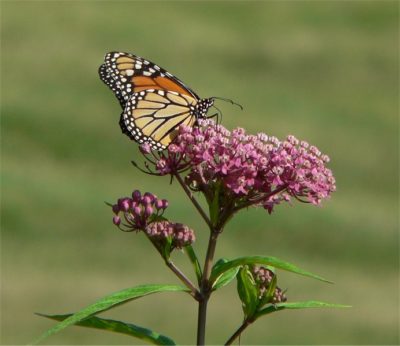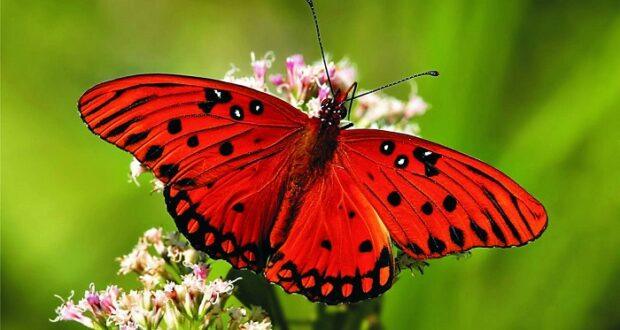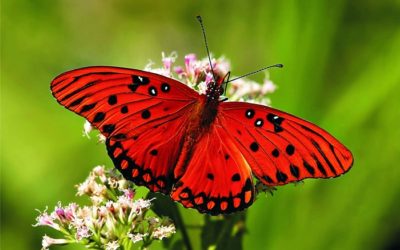Butterflies, nature’s small, beautiful “flying flowers,” are always a welcome sight in our gardens, heralding the arrival of summer. Their vibrant, one-of-a-kind designs inspire artists and delight children. How can we entice butterflies to come to our garden?
Nectar will be available all season long if you have a variety of blooming annuals, perennials, trees, and shrubs. Plant flowers and herbs that will provide food for butterflies at all stages. Caterpillars, newly emerged butterflies, and mature butterflies each have a preferred food source. Butterflies enjoy both large and small flowers, and the garden can be as large as a large plot or as small as a window box. They also prefer open, sunny areas with water and wind protection.
Determine which butterflies are common in your area and then plant flowers that they enjoy. Plant flowers for rarer butterflies as well, because you never know what you might get. To make a shelter, combine herbs and flowers with shrubs and trees. Of course, stay away from insecticides and pesticides.
The Best Source For Non-GMO Heirloom Seeds Is Right Here!
Let’s take a look at some common butterflies-attracting flowers. Remember that these are just the most common; there is an endless list of flowers and herbs for butterflies.
1. Horsemint
Horsemint is classified as a herb. It is at its peak in the late summer and early fall, between September and October. It has lance-shaped leaves and square stems. Horsemint grows in clumps and can reach heights of three feet. It has purple or pink flowers most of the time. Horsemint thrives in moist soil and full sunlight.
2. Dill
Here’s yet another herb. It serves as both food for caterpillars and camouflage for all stages. Dill also serves as a food source for newly emerged butterflies. In late spring and early summer, dill blooms. It is known to grow quite tall, so plant it near the back of your garden to avoid overshadowing smaller flowers. Dill flowers are tiny and bright yellow. It thrives in a variety of soils and amounts of sunlight.
3. Fennel
This herb is adorned with large, “lacy” yellow flowers. Fennel is described as a feathery herb. It prefers full sun and well-draining, moist soil. It can reach a height of three to five feet. Fennel blooms most abundantly in July and August. It can also be used for other household purposes, making it a very useful plant for everyone.
4. Milkweed

Milkweed is a popular attractant for Monarch butterflies.
Despite the fact that it is called a “weed,” milkweed has beautiful flowers and is critical to the Monarch butterfly’s survival. It thrives in the sun and can reach heights of two to six feet. There are many different kinds, and butterflies love them all. Milkweed is distinguished by its thick stalks and large, green, waxy leaves. As the plant matures, the stems become hollow. Milkweed flowers can be pink, purple, or orange and bloom from June to August.
5. Aster
The Aster is a flower with many varieties that blooms in the fall months, but some asters can bloom anytime from spring to the first frost. It is typically a tall plant, ranging in height from 24 inches to five feet. It’s a flower with many petals and a button-like centre. Asters come in white, blue, purple, red, and pink, with yellow centres. Asters thrive in full sun and well-drained soil.
6. Phlox
Phlox is a well-known and attractive flower. It has tall stems that can grow up to four feet tall. It blooms from summer to autumn and prefers full sun and well-drained soil. Phlox blooms come in a variety of colours, the most common of which are pink, red, purple, salmon, and even white.
7. Pansy
Pansies, arguably one of the most popular annual garden flowers, come in an infinite number of colours. Some have as many as two or three colours. Pansies have overlapping heart-shaped petals with face-like markings in the centre. This flower tolerates cold well, but prefers full sun or partial shade. It is a stocky or bushy flower that grows to be only four to eight inches tall.
The Secrets Of Sea Minerals To Grow More “Nutritionally-Dense Food” Than You Can Possibly Eat!
8. Coneflower
This is a low-care prairie flower. It has large, multicoloured flowers with drooping petals and dark centres. It is hardy and blooms for a long time. Coneflowers can grow to be two to four feet tall, with the majority of their blooming occurring in midsummer. This flower prefers full sun but can tolerate partial shade. Coneflowers have a tendency to reach for the sun.
9. Snapdragon
Snapdragons are popular among both children and adults, making this flower popular across the country. Snapdragons are very easy to grow and maintain, and they come in an infinite number of vibrant colours. Full sun to partial shade is ideal for this flower, as is well-drained soil. Snapdragons are a bushy perennial plant that seems to thrive in cooler weather.
10. Stargazer Lily
This flower is tall, slender, and elegant. It can reach a height of three feet and has light pink to deep crimson blooms with dark spots and dark green leaves. The lily is a type of bulb plant. It blooms during the summer, typically between June and July. Stargazer lilies prefer full sun and well-drained soil.
A butterfly garden will add an infinite amount of colour and activity to your life. Take pleasure in watching the caterpillars develop into butterflies and then fly around your flowers and yard. It’s nature at its most basic.
Have you grown a butterfly garden? Which flowers worked best for you? Share your tips in the section below:

